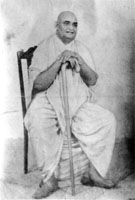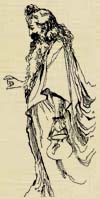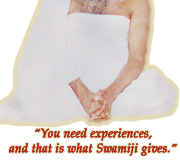Different Forms
Judging Mahatmas by Appearances — Gangaraju Experiences Tapaswiji’s Austerities
Gangaraju used to criticize Tapaswiji Maharaj. He had seen Tapaswiji when the great saint was visiting Kakinada and staying at his Vishnu Ashram there. Gangaraju’s idea was that a yogi should live like an ascetic, so when he saw Tapaswiji smoking cigars, riding in cars, and wearing silk clothes, he formed an increasingly low opinion of the saint. Tapaswiji lived in such a lavish life style, thought Raju, that he could not possibly be a true yogi.
 Shriman Tapaswiji
Maharaj, 1770-1955, completed many difficult forms of spiritual austerities.
Not only twelve years of five-fire tapas (which, in the cold winter months,
shifted to continuous cold water dousing), he remained in continuous samadhi for six years,
and he spent three years standing with legs crossed, arms up holding
onto a tree branch.
Shriman Tapaswiji
Maharaj, 1770-1955, completed many difficult forms of spiritual austerities.
Not only twelve years of five-fire tapas (which, in the cold winter months,
shifted to continuous cold water dousing), he remained in continuous samadhi for six years,
and he spent three years standing with legs crossed, arms up holding
onto a tree branch.
Read more about Tapaswiji Maharaj in Soul Connections.
Gangaraju became a devotee of Shri Swamiji and years later, after Swamiji completed tapas, Gangaraju was sitting outside the ashram building in Adivarapupeta. Swamiji was inside sitting on the dais. Raju was complaining about Tapaswiji Maharaj to someone else saying, “I have gone there. What yogi is this? He would eat huge quantities of parathas (a pan fried, stuffed bread). He wore soft scented silk clothes. He smoked fine cigars and chain smoked cigarettes. Who would believe that he had done so much tapas? I don’t believe it. A real yogi should not be like that. He was not a real yogi. He got driven around in foreign cars and all that. Everywhere he went he wanted luxury.”
Swamiji came to know of this fellow’s talk and got very angry. He sent someone to bring Raju inside. “What’s this you are talking about Tapaswiji Maharaj?” he demanded.
Raju thought that Swamiji would be very pleased if he made a comparison between Tapaswiji Maharaj and Swamiji, especially in their life style, so he continued his complaints about Tapaswiji in front of Swamiji. “Swamiji I had the good fortune of seeing the kingly life style of Tapaswiji Maharaj and now I am seeing your most simple life style. There is no comparison at all. Swamiji, he used to smoke cigars, and very big ones, exactly similar to the ones those Britishers used to smoke. Not only that, his dress was always made of pure shining silk.”
Swamiji silently listened and Gangaraju took this as a sign of liking, so he went on talking. “Swamiji, I got the opportunity to see his room interiors, though he never allowed many to enter his private living room. It contained a Dunlop foam bed, quite thick. It had a very costly bedspread over that and again Dunlop foam pillow. Swamiji, he led a life exactly like a king and compared to him, you have nothing at all. Yours is an example of extreme simplicity, having only few kaupina cloths [loin cloths] and lying down simply on the ground.”
After hearing all Gangaraju had to say, Swamiji asked him, “Have you gone to his ashram?”
“Yes Swamiji, I have been there.”
“Have you asked anyone there about spiritual matters?” Raju had to admit that he had not. “Then how can you comment on his spiritual level, just by looking at him? You are mistaken.” But Raju kept raising doubts. No matter what Swamiji said, Raju would not accept it.
Swamiji simply said, “All mahatmas (great soul, saint) differ in outer, but the inner is the same.”
But Gangaraju went on comparing and describing in detail the living style of Sri Tapaswiji Maharaj, to whom Swamiji always used to give lot of respect. Swamiji put a question to him. “Gangaraju, do you know the types of tapasyas [austerities] that this saint had undertaken during his long life?”
“Swamiji, I have heard about them from the great saint himself but then those austerities can not be compared with yours.”
Swamiji asked Gangaraju to come near and sit before Swamiji and meditate. He made Gangaraju promise not to open his eyes without Swamiji’s permission. With his left thumb Swamiji applied a pinch of vibhuti (blessed ash) on Gangaraju’s brow center. Gangaraju’s eyes closed and his face started showing signs of fear.
Immediately when Swamiji applied the vibhuti at his brow-center, Gangaraju started seeing in quick succession a young Tapaswiji doing many types of very difficult sadhanas (spiritial practices). Swamiji showed him all the great tapas (austerities) that Tapaswiji had undergone. Raju saw Tapaswiji doing panchagni (five fires) tapas, meditating in the intense summer sun with devotees feeding fierce fires on four sides. Raju not only saw this, he also physically felt all the intense physical hardship that Tapaswiji’s body was experiencing.
At first Gangaraju tried to control himself, but he could not tolerate seeing and experiencing all the tapasya that Tapaswiji had performed. He was frightened and started weeping. “Swamiji, I can’t bear it. Swamiji, please, enough. This is a great man and I promise never to speak ill of him, but for God’s sake stop the scenes. Please forgive me.”
He immediately felt the touch of Swamiji’s hand on his brow center and he became calm at once. Swamiji allowed him to open his eyes. “Please forgive me. This is a great man. I am sorry.”
The other devotees in Swamiji’s room were awed by what they had just witnessed. As Gangaraju calmed down, Swamiji told them the story of Sage Vasishta.
 Vasishta
is a rishi, a revered yogi of ancient times. It was Sage Vasishta
who evoked Self realization in Rama, the avatar of the God Vishnu.
Vasishta
is a rishi, a revered yogi of ancient times. It was Sage Vasishta
who evoked Self realization in Rama, the avatar of the God Vishnu.
Prince Rama was discouraged by the impermanence of the world. Concerned, his father, King Dasharatha, called the family guru, Sage Vasishta, to counsel the prince.
The dialogue between Vasishta and Rama, which took place over several days before the king's court and in the presence of many yogis, pundits, saints and even gods, is recorded in the book Yoga Vashita. By the end of the discourse, Sage Vasishta had answered all of Rama's doubts and Lord Rama realized his true nature.
The Yoga Vasishta is considered one of the most important scriptures explaining non-dualistic (advaita) philosophy. It is the only book that Shivabalayogi recommended as authoritative on spirituality.
Shivabalayogi once admitted that in a prior life, he was there during the discourse between Vasishta and Rama. Swamiji's devotees suspect Shivabalayogi is Vasishta.
Vasishta lived the life of an ascetic in a forest ashram. He wore clothes made from the bark of trees and slept on the ground. He was also the guru of the royal family of Ayodhya.
Sometimes King Dasharatha had need of Vasishta’s advice or help. He used to send for the yogi with full royal honors. A large party set out for the hermitage bearing costly gifts, clothes and perfumes. The King’s attendants bathed and dressed Vasishta and mounted him on the King’s own chariot and took him in procession to the palace. There Dasharatha greeted Vasishta at the gate and led him to the throne and made the guru sit there. Vasishta enjoyed all the luxuries of a king. Great feasts were arranged in his honor and he partook of the foods. Then after the matter was concluded, the royal attendants returned Vasishta to the hermitage with all the pomp and ceremony due the monarch.
Once Vasishta got back to the ashram, he took off the royal clothes and returned to the simple life of an ascetic.
Swamiji paused his narration about Sage Vasishta to ask the devotees why Vasishta was behaving that way. They were too spellbound with Swamiji’s presence and words to reply, so Swamiji gave the answer. “See, it is all for you people’s pleasure that we wear all these things. It is not for ourselves. The spiritual is something else.” Because it pleased the devotee to honor him in such a manner, the guru would accept the honors. But it was no reflection on spirituality.
Swamiji explained, “Don’t be carried away by the external appearances of a man. What is inside spiritually is very different from the materialistic world.”
The scenes that Swamiji had showed Gangaraju in that meditation continued to haunt and frighten him for several days. He decided not to speak ill or deride any mahatma, let alone Tapaswiji Maharaj.
Shri Swamiji often used the experience he had given Gangaraju to teach other devotees not to judge yogis by external appearances. Several times Swamiji was with devotees in Kakinada when the subject came up, and he called Gangaraju forward to tell the people about his experience. Gangaraju was eager to warn the others about his own ignorance, and no matter how many years had passed, as Gangaraju related his experiences the images and feelings of what Swamiji had given him remained vivid and fresh.



